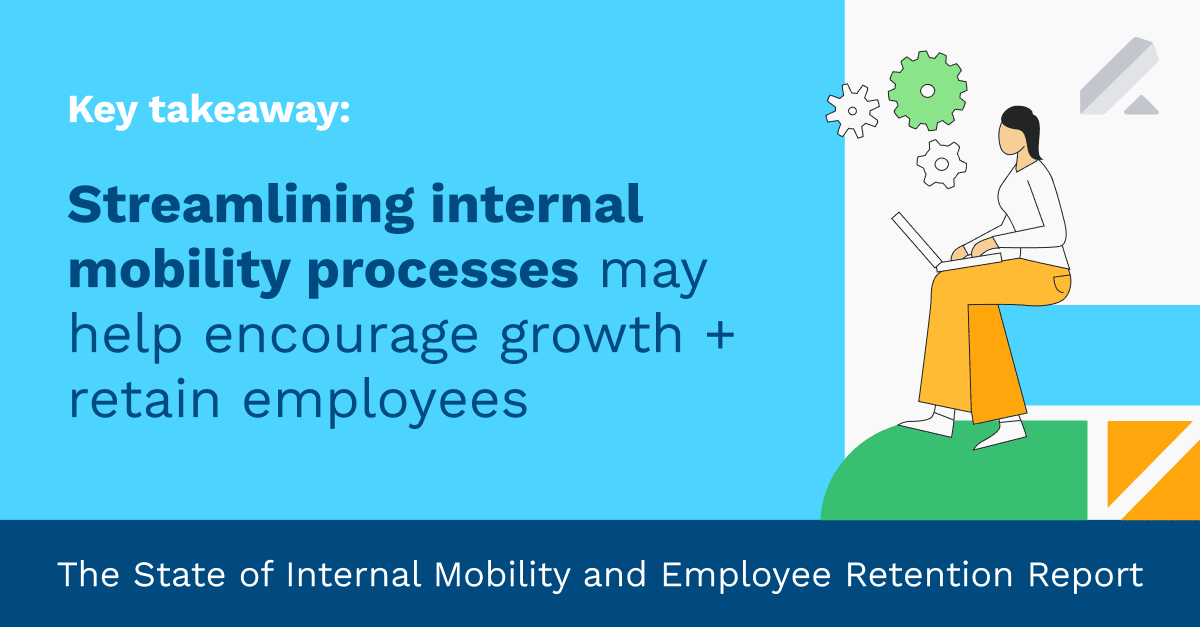Scroll any LinkedIn news feed or HR platform, and you’ll see signs of the Great Resignation — a moment unlike any other we’ve seen before in the world of HR and recruiting.
We were collectively caught off guard by a global pandemic, which exacerbated an already intense competition for top talent and the need to source the best candidates to fill a rapidly growing number of open roles.
While no longer shocking, The Great Resignation has forced organizations of all sizes to rethink how they approach hiring and retention.
Roughly two-thirds of employees are actively searching for new roles today, while 88% of executives across industries continue to see more turnover than normal.
Despite this, we’re slowly entering a new period many are dubbing “The Great Rehire”, and its impact on talent acquisition will be just as bracing as the Great Resignation.
What does this new trend mean for recruiters as companies work to meet the expectations of talent actively looking on the market? Let’s break it all down.

What caused the Great Resignation?
Before covering The Great Rehire, let’s revisit what caused The Great Resignation:
In a nutshell, The Great Resignation is a term used to describe the mass exodus of employees who chose to quit their jobs. A large percentage of the workforce suddenly decided to resign — and if you’re wondering how large, it was around 40%.
Now, from a recruitment perspective, The Great Resignation seemed like a golden ticket for companies looking to snap up talent that was once again on the market.
But it also presented a distinct challenge — namely, understanding why employees were quitting before blindly competing for them in a now vast talent pool.
So what, exactly, caused The Great Resignation in the first place?
Employees are rethinking how they want to work
The pandemic may have forced employees to work from home, but remote and flex work was on the rise long before COVID-19 entered the scene. And, though this working style doesn’t work for everyone (no pun intended), for many, hybrid working options are a must-have.
About three in four employees want flexible work options to stay, while 83% of professionals prefer hybrid work. This desire to have more control over how, where, and when they work means employees look for companies whose visions align with their own.
Takeaway: Employees want more say in how, where, and when they work.
Workers want change, and they’re willing to learn new skills to make it happen
Many employees have felt dissatisfied with the status quo, no longer interested in the traditional ways of working and climbing the corporate ladder.
With the proliferation of freelance work, continuing education, and potential for advancement, employees began to resign in waves, opting to focus on learning new skills to move into the roles they actually want.
This isn’t surprising when you consider the #1 reason people leave their company is a lack of learning and development opportunities.
On the flip side, LinkedIn found that 94% of employees would stay with a company longer if that company showed commitment to helping them learn.
Takeaway: Employees will jump ship for better learning and development opportunities.
——–
These two reasons contributed to The Great Resignation. But there’s a primary cause for it:
There have been more open roles than there have been candidates to fill them. And workers know this — their shift in priorities has put them in the driver’s seat when it comes to recruitment and how they evaluate potential employers.

So, what is The Great Rehire?
In short, The Great Rehire refers to the mass hiring of talent that will take place in 2022 and beyond. We can think of it as organizations bouncing back from The Great Resignation, but it’s not as simple as that.
In fact, The Great Rehire will more or less boil down to a lot of reshuffling.
As a16z puts it, The Great Rehire “is like throwing a pack of cards in the air: you can eventually put the deck back together, but not everyone will end up in the same spot.”
Considering The Great Resignation was triggered by employees holding more sway over how they work, The Great Rehire will require recruiters and talent acquisition pros to approach hiring differently than we did pre-pandemic.
Talent will hold the hiring reins
While there will be more activity from active and passive candidates, especially with more employees looking to switch careers or positions, top talent will hold the reins when evaluating potential employers and choosing the right company based on a myriad of factors — including diversity, culture, development, compensation, and more.
Faster recruiting processes will be key
The need to move top talent through your hiring pipeline more quickly and efficiently will be the key to recruiting success in 2022.
With the average being 38 days, the drive to push candidates through your recruiting processes in a more timely manner to keep up with how quickly candidates want to move will be crucial when hiring this year.
Remote recruiting will become mainstream
Though many organizations have already adopted fully remote recruiting practices, this trend will become a mainstay, especially with mobile and social recruiting on the rise.
Your hiring team will need to be prepared to leverage SMS and text-based recruitment to engage top candidates while offering fully remote options like virtual interviews even once in-person hiring goes back to ‘normal.’
Diversity, equity, and inclusion (DEI) will become a crucial component of recruiting
At Lever, we believe DEI should be baked into every part of your recruiting process. However, in the coming years, you’ll see DEI become a crucial component of hiring as more employees seek out organizations that prioritize diversity.
This includes leveraging diverse talent pools, building DEI-based referral programs, creating DEI tech stacks, and using integrations to help de-bias hiring practices (like interviews and job descriptions).
Talent relationship management will outpace legacy ATS solutions
It’s no longer enough to rely on a legacy ATS or a clunky CRM to run your recruiting. At Lever, we believe talent relationship management (or ‘TRM’) will quickly outpace applicant tracking systems with limited capability to nurture talent.
What does TRM look like come 2022? Well, it involves more data and analytics, richer engagement and nurture of candidates, robust CRM functionalities, and more — including solutions that help drive diversity recruiting.

What to know before you recruit for The Great Rehire
Before your team jumps into hiring new talent, there are a few things to keep in mind as you ramp up your recruiting in 2022.
- Internal mobility is a must-have if you hope to attract new talent and keep existing talent, too. Leveraging the people you already have allows employees to upskill or re-skill, which benefits both them and your organization. An internal mobility program is also a bonus for many candidates.
- You’ll want to rethink how you onboard new hires and how you position your onboarding process during recruitment, as more employees expect robust onboarding.
- Attracting talent will mean pulling out all the stops, including being transparent around compensation, providing modern benefits, and making candidates aware of the impacts and contributions they’ll make when hired.
- Recruiters must cast a wider net in their sourcing efforts to ensure they’re attracting diverse talent—ensuring your company culture and commitments to DEI are reflected in every aspect of your recruitment process.
- Candidate experience is everything, which means your team will need to consider churn data to understand why people leave your organization, what stops candidates from accepting offers, and where recruiting can improve.
- Humanizing your recruiting will help you attract and win over top talent—think about personalization and strategic relationship building with candidates.
- Insights into employee and candidate experience will become your best friend, especially as you optimize your hiring to be more equitable.
- You’ll need a transparent EVP (or ‘employee value proposition’) that gives candidates insight into what working for your company is like, and how they’ll benefit from joining your team.
What candidates want moving forward
Throughout this article, we’ve gone over what caused The Great Resignation, what The Great Rehire means, and what you need to know before you recruit new talent in 2022.
However, candidates have new expectations born from the pandemic, and it’s also critical you’re aware of what candidates expect from their next move.
Here’s what today’s job candidates want from prospective employers.
Flexibility
- Nearly two-thirds of candidates want remote work options even after the pandemic, while 31% want hybrid work options.
- Additionally, 76% of employees see flex work as a top reason for staying with their current employer.
- Your company must be comfortable with remote and flex work and make your remote work policies clear throughout your recruitment process.
Transparency
- Be clear and upfront about what candidates can expect from your recruitment process (such as how long your interview process is).
- Offer insight into compensation, including benefits, equity, salary, and other details candidates will ask about in interviews.
- About half of candidates become frustrated with the lack of transparency in job postings and interviews.
Career Growth
- A top reason people leave companies is the lack of career development opportunities, and candidates will avoid companies for the same reason.
- Making your internal mobility and L&D strategies clear during recruitment can help candidates better evaluate you as an employer.
- Roughly one-third of candidates view career growth as a motivational factor when choosing an employer.
Diversity, Equity, and Inclusion (DEI)
- More than two-thirds of job seekers consider DEI to be a critical factor when considering employment opportunities, while 50% of employees feel their companies can be doing more to drive DEI.
- It’s imperative that your DEI initiatives are communicated during your recruiting process, and that your team is able to answer candidates’ questions about your DEI commitments .
- You’ll also want to ensure that DEI is incorporated into your onboarding process.
Bonus tip: In addition to promoting your organization’s DEI policies and initiatives, you’ll also want to consider promoting your health and wellness program, too.
Studies have found, for example, that 70% of employees enrolled in a workplace wellness program report greater job satisfaction, which aids in retention as well as attracting top candidates to your company.
Download our insightful ATS Buyer’s Guide to get on your way to ripping and replacing your legacy applicant tracking system and onboarding more advanced TA technology.



